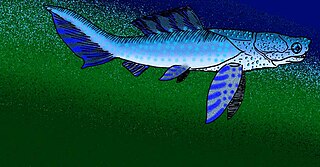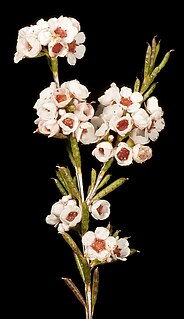
The New Zealand long-tailed bat, also known as the long-tailed wattled bat or pekapeka-tou-roa (Māori), is one of 15 species of bats in the genus Chalinolobus variously known as "pied bats", "wattled bats" or "long-tailed bats". It is one of the two surviving bat species endemic to New Zealand, but is closely related to five other wattled or lobe-lipped bats in Australia and elsewhere.
John William Green is an Australian botanist.

Simosteus tuberculatus is a small arthrodire placoderm from the Gogo Formation of Western Australia. Unlike other members of the arthrodire family Camuropiscidae, S. tuberculatus had a short, snub-nose, as directly implied by the translation of its generic name, "snub-nosed bone." Although S. tuberculatus lacks the characteristic elongated nose, it shares other diagnostic features of camuropiscids, such as cheekplates sutured to the cranium.

Hakea aculeata, commonly known as the column hakea, is a vulnerable species of the family Proteaceae found in the Wheatbelt region of Western Australia. An unusual sculptural species with dense columns of prickly foliage and plentiful clusters of strongly scented blooms in spring.

Helodermoides is an extinct genus of anguid lizards from the Oligocene of North America. The genus is monotypic, including only the species Helodermoides tuberculatus. Helodermoides belongs to an extinct subfamily of anguids called Glyptosaurinae. In addition to many fragmentary bones, several complete skeletons of Helodermoides are known. Like other glyptosaurines, Helodermoides was covered in small scale-like bones called osteoderms. The osteoderms covering its skull are hexagonal, tightly interlocking, raised, and rounded.

Malleostemon is a genus of flowering plants in the myrtle family Myrtaceae, described as a genus in 1983, by John Green The entire genus is endemic to Western Australia.
- Malleostemon costatusRye & Trudgen
- Malleostemon decipiens(W.Fitzg.) Trudgen
- Malleostemon hursthousei(W.Fitzg.) J.W.Green
- Malleostemon microphyllusRye & Trudgen
- Malleostemon minilyaensisJ.W.Green
- Malleostemon nephroideusRye
- Malleostemon nerrenensisRye & Trudgen
- Malleostemon pedunculatusJ.W.Green
- Malleostemon peltiger(S.Moore) J.W.Green
- Malleostemon pustulatusRye
- Malleostemon roseus(E.Pritz.) J.W.Green
- Malleostemon tuberculatus(E.Pritz.) J.W.Green
- Malleostemon uniflorusRye
Persoonia leucopogon is a species of flowering plant in the family Proteaceae and is endemic to Western Australia. It is an erect to low-lying shrub with branchlets that are densely hairy when young, narrow oblong to narrow elliptic leaves and yellow or greenish yellow flowers borne singly or in groups of up to four on a rachis up to 2 mm (0.079 in) long.

Arkyidae is a family of araneomorph spiders first described by Ludwig Carl Christian Koch in 1872 as a subfamily of Araneidae, and later elevated to a full family in 2017.
Malleostemon decipiens is a plant species of the family Myrtaceae endemic to Western Australia.
Malleostemon hursthousei is a plant species of the family Myrtaceae endemic to Western Australia.
Malleostemon microphyllus is a plant species of the family Myrtaceae endemic to Western Australia.
Malleostemon costatus is a plant species of the family Myrtaceae endemic to Western Australia.
Malleostemon minilyaensis is a plant species of the family Myrtaceae endemic to Western Australia.
Malleostemon pedunculatus is a plant species of the family Myrtaceae endemic to Western Australia.
Malleostemon peltiger is a plant species of the family Myrtaceae endemic to Western Australia.
Malleostemon nephroideus is a plant species of the family Myrtaceae endemic to Western Australia.
Malleostemon nerrenensis is a plant species of the family Myrtaceae endemic to Western Australia.
Malleostemon pustulatus is a plant species of the family Myrtaceae endemic to Western Australia.
Malleostemon roseus is a plant species of the family Myrtaceae endemic to Western Australia.
Malleostemon uniflorus is a plant species of the family Myrtaceae endemic to Western Australia.






